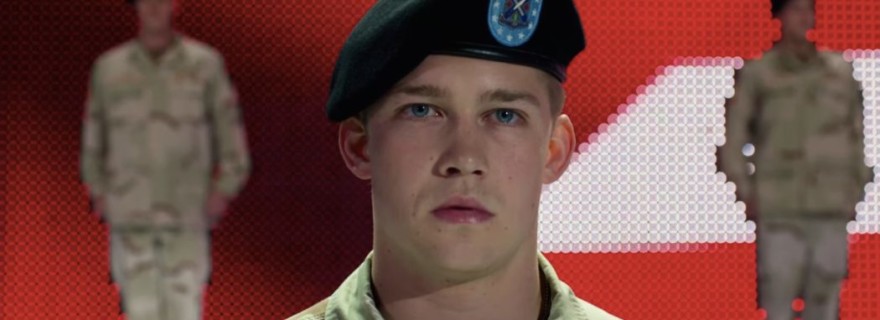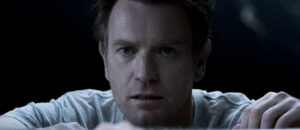'Billy Lynn's Long Halftime Walk'
Movie Rating:
3
‘Billy Lynn’s Long Halftime Walk’ is a curious effort for Ang Lee. The director does some genuinely experimental visual work that can be rather brilliant. At the same time, the film’s script often can’t live up to the craft, despite the efforts of a uniformly strong cast.
Ang Lee is without a doubt one of the most gifted cinematic storytellers alive. He knows exactly where to put a camera at all times and casts every role in his films exquisitely. However, as gifted as he may be as a storyteller, he doesn’t seem to have personal stories to tell. He’s dependent entirely on the material that he’s working with in any given production. While he can sell that material cinematically as well as anyone, it might not always be material worth selling.
‘Billy Lynn’ opens with footage of an attack in Iraq that caught the attention of the media – so much so that the squad is invited to appear at a Thanksgiving Day football halftime show. We meet Billy (Joe Alwyn), a 19-year-old fresh off the battlefield and deeply hungover after a night of strippers and partying before the big game. Flashbacks reveal that he saw his family first after returning from war and that he’s not quite right. His sister (Kristen Stewart) wants him to see a doctor about possible PTSD. But there’s no time for that now because Billy is in the middle of a wild day filled with uncomfortable press conferences, cheerleaders flirting, a manager type (Chris Tucker) wandering around claiming that he’ll sell their stories to the movies, and a rich investor (Steve Martin) who might even buy it. That’s a lot to take in. Plus, there’s a halftime show with Destiny’s Child (they didn’t actually appear) to participate in. This is tricky stuff, especially for someone whose head isn’t quite right.
On a certain level, ‘Billy Lynn’s Long Halftime Walk’ isn’t anything new. We’ve seen many of these tales of damaged soldiers struggling to find a way to return home. On another level, the production is quite new with Ang Lee employing blindingly clear 120 fps 3D visuals to tell the story. That’s an odd seesaw in a film filled with them. The visual technique is oddly appropriate for this story given that the images are almost hyper real. Everything is too clear, too bright, and too much, based on the visual standards that we’re accustomed to in movie theaters. However, that feels right for the story of a damaged soldier stumbling back into the real world after combat and unable to quite come to terms with what he finds. Lee works visual wonders putting viewers inside Billy’s head (especially during the grand halftime show/combat flashback climax), a place where memory, fantasy and reality tend to blur and nothing feels quite right.
The performances are wonderful. Joe Alwyn and his surrounding troops play lost kids who haven’t quite come to terms with what they’ve been doing in the desert. Comedic presences like Martin and Tucker are intriguingly cast against type, which just adds to the off-kilter surrealism of the environment. Even Vin Diesel pops up for a bit on the battlefield and does better than you’d expect.
The movie strikes an interesting balance of realism and heightened drama throughout. Even though he’s telling a story that we’ve heard before, Lee constantly pushes to remind us of the fiction and then pulls us back into the illusion. It’s awkward and woozy, yet suits the material and themes well. The combat scenes come with brutal realism and only appear in sudden bursts when viewers might not expect them. The same can be said of the film’s humor, which is odd and uncomfortable and arrives in unpredictable fits and starts. It’s clear what Lee is doing, crafting a subjective experience inside the head of a protagonist who can’t trust his own mind. It’s clever and it works, but not all the time (or maybe a little too well).
The biggest hurdle that Lee never quite conquers is the screenplay’s mix of realism and melodrama. It features big bold uses of symbolism and grand overwrought speeches throughout, which are just a little too corny and on-the-nose. Lee’s so talented as a visual storyteller that the way he stages scenes frequently conveys what he’s trying to say better than the dialogue. I almost wish that, as an experiment, Lee had filmed every scene in the movie silently as well as with words, then mixed and matched through editing. The weakest moments in the film all come down to the script vocalizing things that don’t need to be said, even though Lee has expressed them all more purely through images.
It’s a shame because those flubbed moments really unbalance the whole movie and make it feel weaker than it actually is. Still, the film has enough strong scenes and even stronger images to make it worth exploring. Ang Lee just didn’t quite get a script to match his vision this time.




Scott
As a techno-geek I’ve been very interested in seeing this since I heard what Ang Lee was doing with the 120fps and 3D. I already know that I am not a fan of the “soap opera” look on TVs that have that feature (and neighbors who employ it, whilst I carefully try to talk them out of it), however I was interested in what a talented filmmaker could do with it if that was the intent from the beginning. Unfortunately though most of the reviews have been poor, and that is making me reconsider whether or not I need to rush to the theater to see it.
One question I have is indeed related to the 120fps. I read that there are only two theaters in the country (one in LA, one in NYC) even capable of showing it in its native format. Does anyone know if this is true? So if I see it somewhere else that cannot natively project 120fps will I still be getting the effect that Ang Lee was going for? Did the reviewer see it in true 120fps?
Josh Zyber
Only two theaters in North America are able to project the movie in its full 4k 3D 120fps. A handful of theaters will play it in 2k 2D 120fps. Most theaters will play it in 2k 2D 24fps.
Pedram
Is there a list of theatres showing it in 120fps (even in 2k) or 60fps?
Josh Zyber
Scott Wilkinson over at AVSForum was able to get some information out of AMC Theaters. I’m not sure what other theater chains are doing.
http://www.avsforum.com/forum/44-movies-concerts-music-discussion/2625257-billy-lynn-s-long-halftime-walk-dolby-vision-hdr-3d-120-fps-atmos-sound.html
“Starting on the evening of November 10, Billy Lynn’s Long Halftime Walk will be shown in what Lee calls ‘the whole shebang’ (4K, 3D, 120 fps, but not HDR) at the AMC Loews Lincoln Square 13 in New York City, the ArcLight Cinerama Dome in Los Angeles, and a few theaters in China and Taiwan. That run is expected to last only one week, and if you live in one of these areas, I strongly encourage you to experience it for yourself there. Then, starting Nov. 17, the movie will enter wide release, and three AMC theaters will present it at 120 fps in 2K: the Dolby Cinema at AMC Village on the Parkway 9 in Dallas (3D, HDR) as well as the AMC Loews Boston Common 19 in Boston and AMC Tysons Corner 16 in McLean, VA (both in 2D and not in the Dolby Cinema auditorium, so no HDR).”
Al
So, Phil did not see it in 4K 3D, at 120 fps, given that there are no showings of it, that way, in all of Canada, correct?
Phil, did you even see it in 2K 120 fps? If you just saw it in standard 24 fps, why did you even comment on the 4K 3D 120 fps, in your review of the film? It’s not relevant, if you didn’t experience it.
Josh Zyber
I’m not sure what format Phil’s screening was in. However, one thing to keep in mind is that Ang Lee worked with Douglas Trumbull when making this movie. For the last several years, Trumbull has been developing a process called “Frame Integrated Motion Analysis” that allows 120 fps photography to be downconverted to 24 fps while (in his description) still retaining better detail and clarity than standard 24 fps photography.
http://www.highdefdigest.com/blog/douglas-trumbull-showscan-digital/
Even if you see the movie projected at 24 fps, it will look different than normal movies and you should get some sense of the effect Lee was going for.
Phil
Hey, Just to clarify. It’s playing in 120 fps 2D at a theater in Toronto. So, I went to see it there to at least get the closest representation of what Lee was going for (did that after the press screening, which was just a standard 4K projection, I believe). I mentioned the 3D just because that’s the part of how Lee shot/designed the flick so it’s worth. I only didn’t specify that i didn’t see the 3D in the review for brevity (and I didn’t really discuss that particular aspect in depth…zing…that’s a pun).. Sorry for the confusion!
Pedram
What theatre did you see it in? I’ve been trying to find 120fps showtimes in Toronto and haven’t had much luck. Is it what Cineplex is calling the “immersive cinema”?
Phil
Sorry! Just saw this. Yep. That’s the one.
Phil
At the Yonge + Dundas theater. But honestly, it underperformed so badly I wouldn’t be surprised if it’s gone by this weekend.
Pedram
Great, thanks! They won’t pick up the phone there so I couldn’t confirm. Apparently that’s the only one showing it in HFR in all of Toronto.
It’s still showing next week there so I’ll go check it out then. I’m actually a fan of HFR and am glad Lee experimented with it. Definitely looking forward to seeing what he came up with.
It’s a shame that they got scared because of critics’ reaction to HFR (do they ever react well to it?) and made most showings SFR.
Al
Did Phil see this in 4K 3D, 120 fps? He lives in Canada, so I’m assuming that he didn’t.
Pedram
I was finally able to see the film in 4k & 120fps a couple days ago (the same 2D showing Phil saw). The clarity was stunning, if a bit unnerving at the start. At times I actually found myself distracted by how clear the picture was, and focusing more on the clarity of detail in the fabric of Chris Tucker’s blazer than the lines he was saying.
Even as a fan of HFR, I will admit that it felt out of place towards the beginning, which had mostly dialogue scenes. It made the picture feel somewhat less cinematic – somewhat, as people say, too real. And that’s just the thing; it’s not about the quality of the image as it is, as Phil put it, what we’ve become accustomed to seeing in theatres. On the other hand, the war time scenes definitely benefited more from it though, as it made them feel decidedly more real – in a good way. After a while however, I became accustomed to the frame rate and while I still appreciated the clarity and lack of judder, I was able to focus more on the story – which I liked! Not loved, however.
All in all, I’m definitely glad I was able to see it in 120fps. It’s a shame it got such a backlash from those who have a platform to write about it in published form. I for one definitely want to see more films in that format, especially more action oriented and sci-fi ones. I feel that the future is being held back with very few HFR films, and while slower movies might benefit more from a variable frame rate, it’s not something Hollywood should stop experimenting with. If nothing else, it’s something that can’t really be reproduced at home right now.